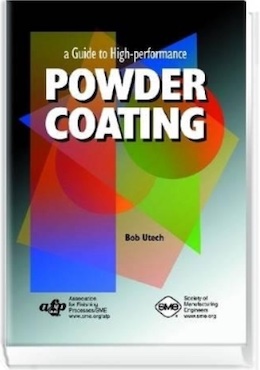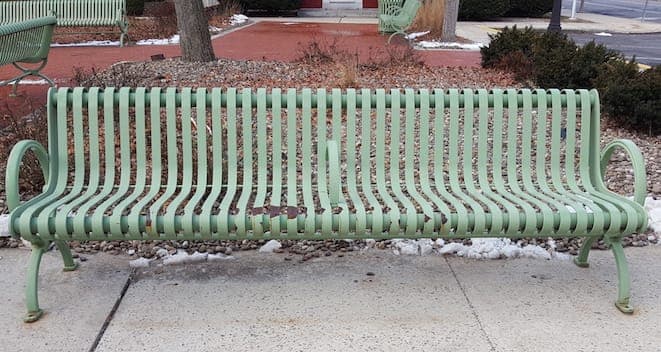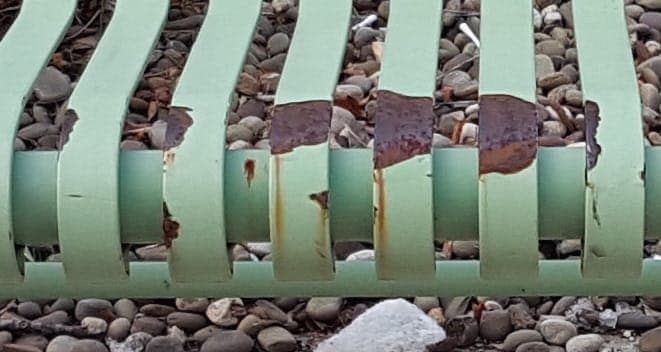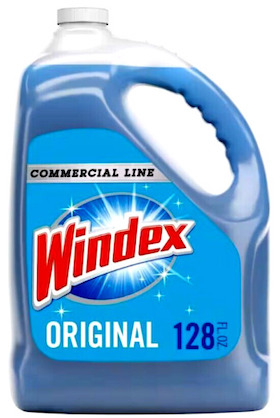
-----
Can we do powder coat on top of powder for rework
Please see also --
• Topic 52691 "Test to determine if powder coating is fully cured"
• Topic 15333 "MEK/Solvent Rub Test? Cure Tests"
• Topic 37637 "Re-curing powder coat"
Q. Hello People,
I will really appreciate your help, just want to place this question: What is the best way to rework the powder coating (electrostatics)? or a website where can I consult.
Kindly,
Eliseo [last name deleted for privacy by Editor]- Juarez, Chihuahua, Mexico
2004
A. You've found the right website, Eliseo, with 50,000 Q&A's about metal finishing. But you need to post specifics of your situation -- because there are so many types of parts, so many substrate materials, so many types of thermoplastic and thermoset powders, and so many individual situations. By "rework" do you mean apply touchup paint or do you mean apply a second layer, or completely remove defective powder coatings and start over? Thanks.
Maybe start with letter 1152, "Touching up powdercoat" which introduces a number of different approaches. Good luck!
Regards,

Ted Mooney, P.E.
Striving to live Aloha
finishing.com - Pine Beach, New Jersey
Ted is available for instant help
or longer-term assistance.
A. Eliseo,
What is it you are trying to do? If you would like to strip the coating completely off, you may want to try a fluidized sand bed or a molten salt bath, you can blast it with abrasive media, you can dip it in stripping solution or depending on the type of powder you can use paint thinner.
Then again, you might just want to quickly sand it and paint a second coat and rebake it.
- Juarez, Mexico
April 29, 2009
Q. I have cured powder parts that for what ever reason need to be reworked. Can I just put on another layer of powder without stripping off the first layer? Are there down sides in doing this?
Dave. StewartQA - Bowling Green, Kentucky
2007
A. In my experience you can do this once only. You get two chances to get it right, no third.
But... this depends on the competence of the first coat. If its well adhered, to a well prepared and pretreated substrate, and provided that you are using the same type of powder, and that you sand the surface of the first coat to get intercoat adhesion. Then you should be able to recoat.

Geoff Crowley
Crithwood Ltd.
Westfield, Scotland, UK

A. Hi,
Applying a second or even a third coat of powder is common practice when alloy wheel manufacturers, OEM, powdercoat -i.e. primer, aluminium then finishing off with a transparent polyester powder. You will just have to evaluate for yourself to see if a second coat is possible. This is because some powders are more self-limiting than others as to the amount of powder you can apply. You could heat the object prior to applying the powder. This method will always work as the powder does not depend upon the electrical charge applied to the powder but tends to melt as it settles upon the hot metal substrate.
Terry
Birmingham, United Kingdom
A. Hi.
As per my experience you pass your components in 100 ° C temp and when parts get a temperature more than 70 °C immediately coat the second layer and then pass it to oven as per your specification. I'm sure that you'll get a good adhesion of both the layers and rework would be successful.
Wet process employee - Pantnagar, Uttrakhand, India
A. It depends on the COATING REQUIREMENTS.
But here is some advice according to my experience;
Analyze residual coating
Strip part
Sandblast
Keep it dust free
Process coating
Verify requirements
- Minneapolis, Minnesota, USA
A. It's always better to get it right the first time but we've all had rejects. Whether or not you can recoat the parts depends a lot upon the actual powder your using and the operator applying it. Some powders just don't recoat well and some operators don't have the experience and/or ability to setup the equipment properly to make acceptable recoats. In any event, you need to sand between the coat or you will not get acceptable longevity of the topcoat being applied to the base coat. Peeling will occur if the base coat has been totally cured before you have put another topcoat over it. With proper sanding and powder application, you can achieve great success, however you may reduce the powder manufacturers performance statistics for the powder quality by the addition of more powder than is called for by the manufacturer.
 Bob Utech Benson, Minnesota |
 Ed. note: Bob is the author of: "High Performance powder Coating" on eBay or AbeBooks or Amazon [affil link] |
A. Yes, You can do recoating, First Scancheck the first (prime) coat for any corrosion or loose paint, Roughen it with sandpaper, Pre heat the component.
During coating reduce the charge of the gun and increase the powder flow, not all guns support this the GUN should also be supportive, use DIPOLE guns as they are the best for this act.
Regards,
- Coimbatore, TAMILNADU, INDIA
It is our sad duty to pass along the information that the knowledgeable Mr.Shankar was lost to Covid/Corona.
He was awarded with honorable medal by then Indian president Ms. Pratibha Patil. R.I.P.
2007
A. Yes you can recoat the compound. In two different ways you can recoat:
1) Preheating the compound to certain temperature (100 °C) and directly you can apply the powder. Here no gun setting is required or anything required. You can coat as such your specified gun setting. But practically it can be carried out only in big compound because preheating small compound each time and coating is quite difficult.
2) For small compounds, just put sandpaper, reduce the voltage of the gun and increase the powder flow.
- Coimbatore, TamilNadu, India
June 26, 2009
Q. How is the reworking method for thermosetting powder coated paint?
Nihal Pathirana- Ja Ela, Sri Lanka
March 25, 2014
by Society of Manufacturing Engineers
on AbeBooks
or Amazon
(affil link)
Hi Nihal. We appended your inquiry to a thread on the same subject, and maybe it will help you. But what do you mean by "reworking"? Do you mean a small touch-up, or attempting to put a new color onto a previously powder coated part, or do you mean stripping and starting over because the first coat is blistered, orange-peeled, or otherwise defective? Please detail your situation. Thanks!
Regards,

Ted Mooney, P.E.
Striving to live Aloha
finishing.com - Pine Beach, New Jersey
Ted is available for instant help
or longer-term assistance.
Q. Hi, I have just had my Mongoose bmx bike frame powder coated and very happy with the finish but not happy with color, do I have to sand blast again or can I change colors without without sandblasting? I would appreciate any advice on this. Thanks Aussie Ray
Raymond Peters- Melbourne, Victoria, Australia
February 3, 2016
Q. If a part was already powder coated. Can I add a second layer of powder coating but with more texture. what are the pros and cons
JOSH SNYDER- IRVINE, California, U.S.A
June 6, 2016
Q. Getting parts powder coated and we have noticed the thickness varies from 35 - 50 micron. I contacted the powder coater and he said he would coat them. We require 60 -80 micron. We are using a Matte finish powder. Is re-coating product satisfactory from a performance and appearance point? What are the options?
FRANK KAISERBUYER - SYDNEY
August 30, 2016
A. Hi Frank. You are the customer and you specified the 60-80 micron thickness for some reason, so you must know the performance and appearance requirements. It is up to you to determine if the reworked parts are satisfactory. But we appended your inquiry to a thread where a number of experts have said that yes indeed it can often be done satisfactorily. Good luck.
Regards,

Ted Mooney, P.E. RET
Striving to live Aloha
finishing.com - Pine Beach, New Jersey
Ted is available for instant help
or longer-term assistance.
Q. Sirs,
I had a question about powder coating in full-matting; the clients use this coating. Reworking cause second coating peel off, first coating is normal. I checked my client's devices which oven temperature is normal. What reason cause second coating peel off? I look forward to answer by you, thanks.
- Taiwan,Tainan
October 8, 2016
New powder coating over old
Q. Hello Everyone My first post here!
I have a large powder coating contract with a local city government. There are about 100 pieces largest is 32 8 ft long 400+ pound park benches and a bunch of 22 and 32 gallon trash cans. These item were powder coated new 15 years ago. 90% of the powder is still attached very solid with a mill thickness between 2 and 5. My plan is to sand blast any and all rust and loose powder coat off and powder coat over the old powder. This is the client's idea to keep the cost as low as possible. I have never powder coated over old powder before ...is there any special pretreatments required? Should I have the old powder coat tested for compatibility of the powder going over the top?


- ROMNEY, West Virginia
June 28, 2017
A. My Friend,
You are on the edge of a very deep precipice.
This product is 15 yrs old.
You do not know the formula of Powder previously applied.
There is no upside for a contract powdercoater taking on a refurbishment job without taking complete control of the process. Imagined Cost saving by your client could very well turn into real losses for your company as undoubtedly you would be held responsible for performance.
There are simply too many risks involved with your intended process.
Fully blast or chemically strip & blast then apply a compatible restoration agent to the most heavily corrosion affected areas (Epirez comes to mind), sand off, pretreat as appropriate, then apply a quality thermoplastic powder.
That way you will avoid law suits and have a product your customer and yourself can be proud of.
Hope this helps,
Bill
Trainer - Newcastle Australia
![]() Thanks William. Those were exactly my thoughts but I did not have sufficient personal experience to confidently state that the proposed approach was a terrible idea.
Thanks William. Those were exactly my thoughts but I did not have sufficient personal experience to confidently state that the proposed approach was a terrible idea.
Regards,

Ted Mooney, P.E. RET
Striving to live Aloha
finishing.com - Pine Beach, New Jersey
Ted is available for instant help
or longer-term assistance.
![]() Thank you for your time and input.
Thank you for your time and input.
I thought this is what I would hear back. I've been telling myself the whole time this is not a good thing. I have always stripped everything to bare metal.The best thing is I haven't signed the contract yet.
Mountain State Powder Coating - ROMNEY, West Virginia USA
A. I agree with what's been said.
We would not undertake such a contract. The coating you apply might be good, but it's adhesion is relying on the old coating (assuming you get good adhesion to that old coating). And the old coating is failing already (actually I think its done pretty well to last 15 years with no other corrosion protection system underneath).
Start from bare metal and take full control.

Geoff Crowley
Crithwood Ltd.
Westfield, Scotland, UK

Q. Hi to all!
I have a question ... I have now a coating line with different colors, sometimes have been events where I have coated by mistake with X color a piece, but it need to be recoated with other color.
My question would be, can I just recoat other color over the first layer (different color)?
or what would be the right rework process?
Substrate (CRS), all parts are flat; I have a restricted pretreatment process.
- Juarez, Mexico
October 19, 2017
A. If you are confident of the original coating (and that should be if you did it), then adhesion between the coast is your issue. You could do something as simple as sanding the original coating and over coat it.
If the 1st coat is fully cured, there will be no bonding due to the coast curing together, so sanding is probably best and easiest. We sometimes do that, mostly successfully.

Geoff Crowley
Crithwood Ltd.
Westfield, Scotland, UK

A. We have done this many times without issue. Most times, it's as easy as making sure the surface is clean. We use Windex Commercial Line ⇦ on eBay or Amazon [affil link] and tack cloth ⇦[this on eBay or Amazon affil links] . As long as the gun settings are correct for recoating, it typically covers very well. In some cases though, the colors are important. For example, we needed to coat some black signs silver. They turned pink in some areas. Another example, we coated some doors yellow on one side, white on the other. Any yellow over spray under the white had bled through.
Kayla Fagenproduction manager - Cedar Rapids, Iowa, Usa
Q. I am trying to powder a translucent "Penny Copper" over a chrome. The chrome powder needs to be sanded due to orange peel. Will this work? It is a Harley D air breather cover. And I am just a hobbyist looking for the smoothest finish.
Gary Pe- Olathe, Kansas US
November 29, 2017
A. Hi Gary. I am not totally clear on the question. You want to sand "the chrome powder". You did that chrome powder coating yourself or are otherwise sure that it is actually a layer of powder coating, and not "chrome-look paint" or real nickel-chrome plating? If so, yes, the previous comments on this page would be applicable.
I think the overall best route to a translucent copper tint chrome look might be "chrome look" spray painting followed by the copper tinted translucent topcoat; we have a number of threads about chrome-look spray paint.
Regards,

Ted Mooney, P.E. RET
Striving to live Aloha
finishing.com - Pine Beach, New Jersey
Ted is available for instant help
or longer-term assistance.
Q. Yes. I sprayed the part with chrome powder, but it was orange peeled. I have stripped and resprayed 4x now. I think I may need to get a grounding rod. I guess trial and error.
Thanks for the response! I should have just sprayed the copper over the original chrome piece. It looked really good when I did that, but it was the second attempt (after sanding), and you could see the little scratches from sanding.
Olathe, Kansas US
Q, A, or Comment on THIS thread -or- Start a NEW Thread
